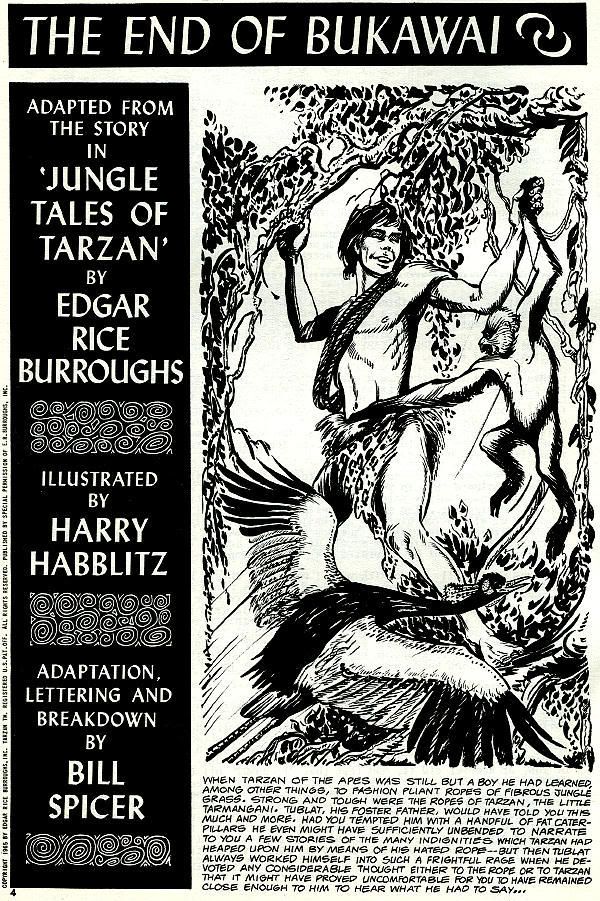
Number 175
Bill Spicer's Fantasy Illustrated
Comics fandom was still in its infancy in 1963; while youthful fan editors were attempting to put out fanzines on crude spirit duplicators, other more mature fans were setting the course that fandom would follow. Bill Spicer was one of those innovative editors. He's been a fan for a long time, predating modern comics fandom for several years with EC fandom. He was also one of the fans responsible for thrusting artist/writer Carl Barks out of his anonymous work for Dell-Disney.
In 1963 his fanzine Fantasy Illustrated was published. It was printed, not in the purple ditto or crude mimeo form of most fanzines, but as a professional offset-printed magazine, with color covers and black and white interiors. Offset printing wasn't exactly new: Ronn Foss had published Alter Ego #5 in offset a year earlier. Comic strips in fanzines weren't new either. Roy Thomas wrote and drew the satire "Bestest League Of America," which ran in Alter Ego #1-3, and numerous other super-hero pastiches were published in the fanzines of the day, usually laboriously drawn in ballpoint pens on ditto masters. What was new with Fantasy Illustrated was publishing fan-produced comic strips much like the professional artists and writers produced theirs, with professional production and editorial direction from Spicer.
Despite its professional production, Fantasy Illustrated #1 showed the birth pains of most fanzines. Artwork varied in quality from amateurish to professional. Three of the four stories were drawn from pulp writing of the 1930s and '40s. For some reason Spicer didn't have artwork for a back cover and padded his editorial to fit in three pages which would otherwise have been blank, but the feeling was there…something new had arrived.
Landon Chesney produced the first cover, in my opinion the best of any of the subsequent issues.
For the contents, Alan Weiss' first printed offset job was very amateurish, drawn in pen with scratchy lines. It was a Jon Jarl story, "The Ancient Secret," written originally by Otto Binder as the text feature for an issue of Captain Marvel Adventures. Richard "Grass" Green, who went on to do professional comics, underground and fanzine work until his death in 2002, contributed "Will The Real Lance Lightning Please Sit Down!", a funny superhero parody suited for his cartoony style.
The third feature was the crudely drawn "Moon Ants" by Buddy Saunders, another pulp story attributed to "Thornecliff Herrick," an old Planet Comics pen-name. Finally, part 1 of "Adam Link's Vengeance," from the classic story by Otto Binder, rounded out the issue. D. Bruce Berry did the artwork. Parts 1 and 2 were reprinted in full in Spicer's Graphic Story Magazine #13 a few years later.
Future issues did some improving, especially issue #2.
It opened with "The Life Battery," taken from yet another Binder story, and illustrated by Landon Chesney. It was later reprinted in color in Spicer's underground comic, Weird Fantasies. I prefer this original printing, however, which was drawn to be printed in black and white.
Issue #3 has a cover by Chesney inspired by EC's science fiction titles.
Number 3 opened with Edgar Rice Burroughs illustrator Harry Habblitz' version of "The End Of Bukawai," a story from Jungle Tales Of Tarzan. While not drawn in a real comic book style, it is an outstanding story from this issue.
Chesney did a collaboration with Comic Book Price Guide publisher Bob Overstreet, "A Study In Horror," similar to, and done better by Harvey Kurtzman as "House Of Horror" in Tales From The Crypt #21. Overstreet soloed on a story called "March 25th" which showed that as an artist his future destiny definitely lay in publishing. The back cover of #3, done by the late Russ Manning, used color overlays to beautiful effect in a surrealistic fantasy illustration. You can see it at the top of this page.
Fantasy Illustrated begat Graphic Story Magazine which begat Fanfare, and then at some point I lost track of Spicer's publishing career. When I saw these early issues as they originally appeared I felt that they were a new direction for comics fandom, toward producing a more professional, albeit alternative, comic book. When underground comix came out a couple of years later their format didn't surprise me, because I'd already seen it with Fantasy Illustrated.
(This article is adapted and edited from an unpublished article I wrote in the early 1980s. It also covered FI issues 4-6, which I no longer own, and for which I have no scans.)
0 nhận xét:
Đăng nhận xét